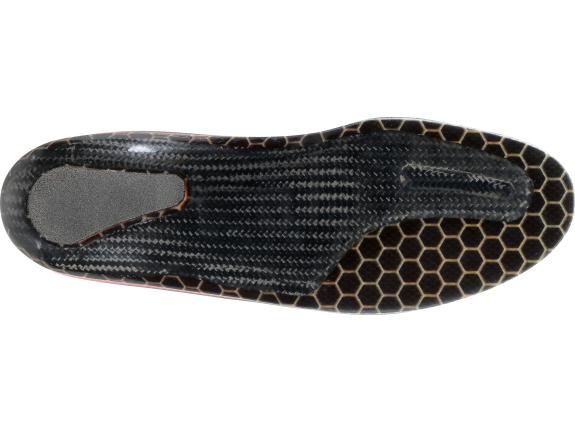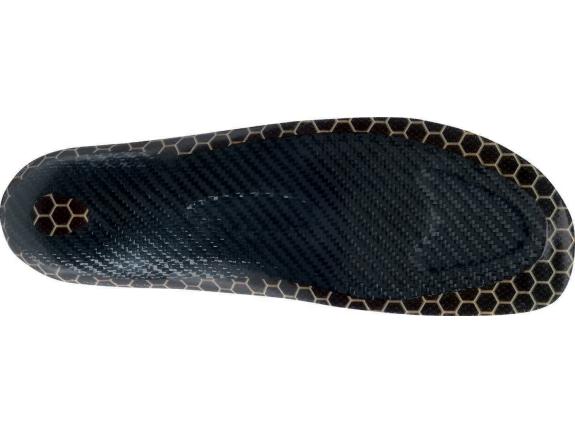Hallux rigidus and Limitus
In this article
- Introduction
- Classification Systems
- Orthotic Treatment Options
- Hallux Rigidus Insole
- Hallux limitus Insole
- Carbon edition Hallux
- Carbon Hallux Calca with U-pad
- Carbon Stong
- Private Assessments
Introduction
Hallux limitus and rigidus are common and often disabling causes of foot pain that progresses in severity as time progresses. Arthritis in the first metatarsophalangel joint (MTPJ) is often classified as Hallux limitus or rigidus when the joint range of motion is restricted.
Hallux rigidus and limitus are characterised by damaged cartilage and osteophytes on the dorsal joint line resulting in a stiff and painful joint.
Hallux Rigidus /limitus is a structural problem which without surgical intervention, treatment will focus on pain/symptom reduction.
This can be achieved in a number of ways often aiming at reducing the dorsiflexion moments acting on the hallux.

Classification Systems
There are a number of different classification systems, which are often based on clinical findings and imaging.
One such system is the Coughlin and Shurnass classification:
| Grade | Dorsiflexion | Radiographic findings | Clinical Findings |
| 0 | 40–60 degrees and/or 10-20% loss compared with the normal side | Normal | No pain. Only stiffness and loss of motion |
| 1 | 30-40 degrees and/or 20-50% loss compared with the normal side | Dorsal osteophytes. Minimal joint space narrowing, minimal periarticular sclerosis, minimal flattening on the metatarsal head. | Mild or occasional pain or stiffness, pain at all extremes or dorsiflexion and/or plantarflexion on examination |
| 2 | 10-30 degrees and/or 50-75% loss compared with the normal side | Dorsal, lateral, and possibly medial osteophytes giving a flattened appearance to the metatarsal head. No more than ¼ of dorsal joint space is involved on the lateral radiograph. Mild to moderate joint space narrowing. | Moderate to severe pain and stiffness that may be constant. Pain occurs just before maximum dorsiflexion and maximum plantarflexion on examination. |
| 3 | <10 degrees and/or 75-100% loss compared with the normal side. There is a notable loss of MTPJ plantarflexion as well (often <10 degrees plantarflexion) | Same as grade 2 but with substantial narrowing, possibly periarticular cystic changes, more than ¼ of dorsal joint space involved on lateral radiograph, sesamoids enlarged and/or cystic and/or irregular | Nearly constant pain and substantial stiffness at extremes of range of motion but not at mid-range. |
| 4 | Same as grade 3 | Same as grade 3 | Same criteria as grade 3 but there is definite pain at mid-range of passive motion |
Orthotic Treatment Options
Insoles aimed at reducing the dorsiflexion moments on the 1st MTPj are often made in carbon fibre and have either single extensions or a full carbon forefoot.
Buchanan Orthotics supplies a range of insoles aimed at the treatment of Hallux Limitus / rigidus.
Hallux Rigidus Insole
The Hallux Rigidus insole is reinforced across the full width of the met heads and full length of the toe (shown in red) to restrict movement of the metatarsophalangeal joint to avoid painful movement.
- Comes as a pair
- Stiffening of the full forefoot
- Wide or medium
- Slight arch support
Hallux limitus Insole
The hallux Limitus insole has a Morton’s extension (in a reinforced, red material) to limit movement of the metatarso-phalangeal joint and reduce painful movement.
- Comes as a pair
- Stiffening of hallux area (to the end of the toe). The remainder of the forefoot is levelled with a compensatory material to avoid any ridges in the insole.
- Wide or medium
- With or without cut out of the reinforcement under the heel
- Slight arch support
Hallux Rigidus (top) and Hallux Limitus (bottom) insoles
Carbon edition Hallux
The carbon edition Hallux insole which is part of the carbon edition family has a prepreg carbon fibre construction to reduce the painful movement of the hallux. 1.5mm microfibre cover with a thinned area under the hallux. The compensation insole has a 3/4 length reinforcement to allow natural movement of the MTPJs with full lelengthgnth top cover.

The carbon edition insole is thinned under the hallux and has a soft small metatarsal dome
There is also a shorter version with reinforcement only to just beyond the 1st MTPJ available.
- Sold as individuals- order single insole for unilateral use with compensation insole on the unaffected side
- Hallux Limitus Standard comes in Narrow and wide
- Hallux Limitus short only comes in one width
- Slight arch support
- Small met dome
- Thinner than the red and blue alternatives
Carbon Edition Hallux Rigidus Family comparison
Carbon edition Compensation insole
Carbon Hallux Calca with U-pad
The Carbon Hallux Calca with U-Pad is similar in construction to the standard Carbon edition Hallux Limitus insole with the addition of heel offloading to help with the treatment of plantar heel pain in addition to 1st MTPj problems.
- Prepreg carbon fibre construction
- Microfibre on Dry top cover
- ARUfoam heel pad
- Plantar tendon structure can be relieved by a partial cutaway
- Sold as a single left and right or as a pair

Carbon Stong
The Carbon Strong is the newest edition to the carbon Hallux family it features a full-length and width prepreg carbon fibre footplate to restrict forefoot flex.
The Carbon strong combines strength with thinness and provides the strongest resistance to movement of all the carbon hallux insoles.







